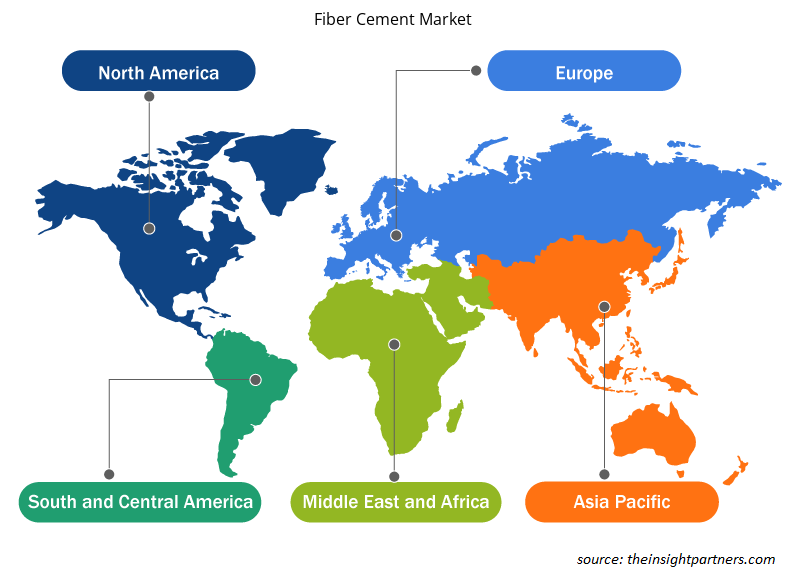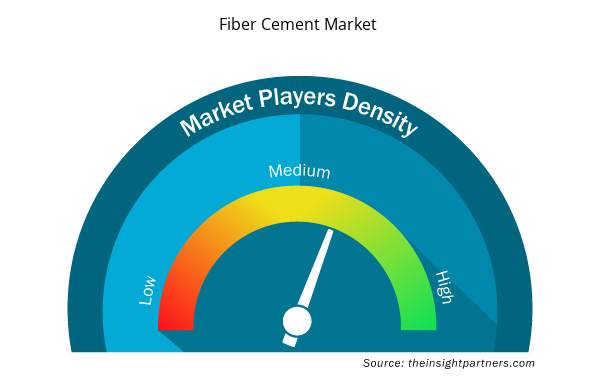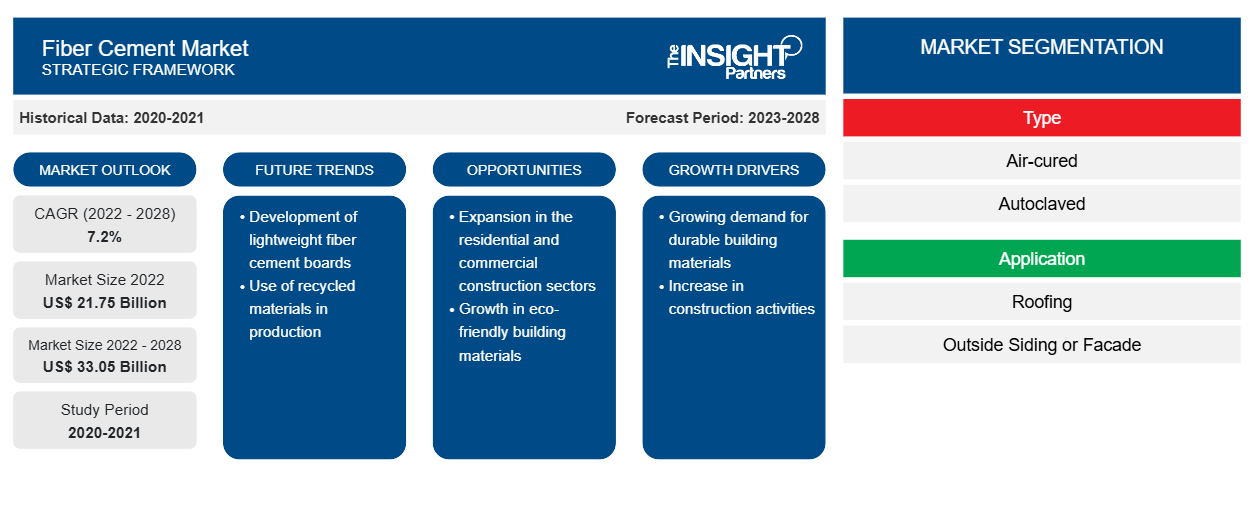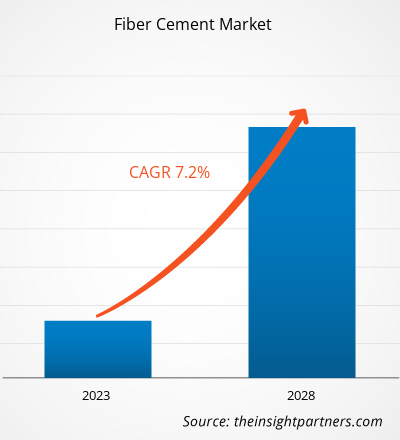[Informe de investigación] Se espera que el tamaño del mercado de fibrocemento crezca de US$ 21.748,45 millones en 2022 a US$ 33.052,23 millones en 2028; se estima que registrará una CAGR del 7,2% de 2022 a 2028.
El fibrocemento se utiliza habitualmente como material de revestimiento exterior, ya que ofrece una excelente durabilidad y resistencia a la intemperie y al fuego. Además, el fibrocemento se utiliza a menudo como material para techos debido a su capacidad para soportar condiciones climáticas adversas, como lluvias intensas, granizo y viento. Además, el fibrocemento también se puede utilizar para trabajos de molduras y molduras, ya que es fácil de moldear y se puede pintar o teñir para que combine con el exterior del edificio. También se utiliza con frecuencia en edificios comerciales, como hospitales, escuelas y edificios de oficinas, ya que ofrece una opción duradera y de bajo mantenimiento para sus exteriores.
En 2022, Asia Pacífico tuvo la mayor participación en los ingresos del mercado mundial de fibrocemento . La demanda de fibrocemento está aumentando en Asia Pacífico debido a la creciente conciencia sobre los beneficios del fibrocemento. Esta región se ha destacado como uno de los mercados más destacados para la utilización de tableros de fibrocemento debido al aumento de las actividades de construcción. Además, las iniciativas y políticas gubernamentales como Make-in-India fomentan la instalación de diferentes plantas de fabricación en la India. El aumento de las inversiones extranjeras directas también conduce al crecimiento económico en la región. Se prevé que el creciente número de usos de tableros de fibrocemento en numerosos sectores residenciales y no residenciales aumente la demanda de tableros de fibrocemento en Asia Pacífico en los próximos años. En la India, la industria de la construcción es la segunda industria más grande después de la agricultura, y representa aproximadamente el 11% del PIB del país. La industria de la construcción y la edificación contribuye en gran medida al crecimiento del mercado.
Personalice este informe según sus necesidades
Obtendrá personalización en cualquier informe, sin cargo, incluidas partes de este informe o análisis a nivel de país, paquete de datos de Excel, así como también grandes ofertas y descuentos para empresas emergentes y universidades.
- Obtenga las principales tendencias clave del mercado de este informe.Esta muestra GRATUITA incluirá análisis de datos, desde tendencias del mercado hasta estimaciones y pronósticos.
Impacto de la pandemia de COVID-19 en el mercado del fibrocemento
El sector de la construcción ha sido el principal contribuyente a la demanda de fibrocemento. La pandemia de COVID-19 afectó negativamente al crecimiento del sector de productos químicos y materiales y al mercado de fibrocemento. La implementación de medidas para combatir la propagación del SARS-CoV-2 afectó negativamente al crecimiento de varias industrias. Industrias como el embalaje, los bienes de consumo, la automoción y el transporte, los textiles y la construcción se vieron afectadas negativamente por las interrupciones en la eficiencia operativa y las cadenas de valor debido al cierre repentino de las fronteras nacionales e internacionales. Durante la pandemia de COVID-19, la caída de los ingresos y el aumento de los desafíos de ejecución de proyectos llevaron a la contracción del sector en la mayoría de los mercados, con un impacto negativo correspondiente en la fuerza laboral. Los constructores experimentaron retrasos y un aumento de los costos de las materias primas importadas y los materiales de construcción externos debido al cierre prolongado de muchas fábricas. El daño a la industria de la construcción obstaculizó la demanda de fibrocemento durante la pandemia.
Perspectivas del mercado
La creciente demanda de edificios energéticamente eficientes impulsa el crecimiento del mercado del fibrocemento
Según el Programa de Asistencia para la Gestión del Sector Energético, casi un tercio de la energía mundial se consume en edificios residenciales, públicos y comerciales para refrigeración, calefacción, ventilación, cocina, refrigeración, iluminación, calentamiento de agua y funcionamiento de dispositivos eléctricos y mecánicos. La modernización de las ciudades en los países en desarrollo y el aumento del ingreso per cápita impulsan el uso de energía en edificios de todo el mundo. El alto consumo de energía en edificios públicos, residenciales y comerciales crea una necesidad de ahorro energético. Según la Agencia Internacional de la Energía, se espera que los edificios representen aproximadamente el 41% del potencial de ahorro energético mundial para 2035, y el sector industrial y el sector del transporte tendrán el 24% y el 21%, respectivamente. Se aplica una capa de fibrocemento al edificio para reducir la transferencia de calor a través de las paredes, manteniendo el interior más cálido en invierno y más fresco en verano, lo que ayuda a reducir el consumo de energía. Según el Manual de Fundamentos de ASHRAE, el fibrocemento tiene un valor R de 0,15, que es mejor que el valor del ladrillo y la piedra.
Tipo de información
Según el tipo, el mercado mundial de fibrocemento se divide en curado al aire y curado en autoclave. El segmento de los curados en autoclave tuvo una mayor participación de mercado en 2022. El fibrocemento curado en autoclave está hecho de una mezcla de cemento, arena, fibras de celulosa y otros aditivos. La mezcla se forma en láminas o tableros y luego se cura en un autoclave, que es un recipiente de alta presión que aplica calor y vapor al material. El proceso de curado en autoclave provoca una reacción química que fortalece el material, haciéndolo más duradero y resistente al agua, al fuego y a las plagas. Generalmente se utiliza en una amplia gama de aplicaciones, que incluyen techos, revestimientos, pisos y como soporte para baldosas cerámicas . Además, el fibrocemento curado en autoclave también es conocido por su versatilidad y flexibilidad de diseño, ya que se puede hacer que imite la apariencia de otros materiales de construcción, como la madera o la piedra. También está disponible en varios colores y texturas, lo que lo convierte en una opción popular para proyectos de construcción residenciales y comerciales.
James Hardie Industries plc, Etex NV, Swisspearl Group AG, CSR Ltd, NICHIHA Corp, Plycem Construsistemas Costa Rica SA, Compagnie de Saint Gobain SA, Century Plyboards Ltd, Everest Industries Ltd e Isam Khairi Kabbani Group son algunos de los actores clave que operan en el mercado global de fibrocemento. Los actores del mercado se centran en proporcionar productos de alta calidad para satisfacer la demanda de los clientes. También están adoptando estrategias como inversiones en actividades de investigación y desarrollo y lanzamientos de nuevos productos.
Informe Destacado
- Tendencias progresivas de la industria en el mercado del fibrocemento para ayudar a los actores a desarrollar estrategias efectivas a largo plazo
- Estrategias de crecimiento empresarial adoptadas por los mercados desarrollados y en desarrollo
- Análisis cuantitativo del mercado de fibrocemento de 2020 a 2028
- Estimación de la demanda mundial de fibrocemento
- Análisis de las cinco fuerzas de Porter para ilustrar la eficacia de los compradores y proveedores que operan en la industria
- Avances recientes para comprender el escenario competitivo del mercado
- Tendencias y perspectivas del mercado, así como factores que impulsan y restringen el crecimiento del mercado de fibrocemento
- Asistencia en el proceso de toma de decisiones destacando las estrategias de mercado que sustentan el interés comercial, lo que conduce al crecimiento del mercado.
- El tamaño del mercado de fibrocemento en varios nodos
- Descripción detallada y segmentación del mercado, así como la dinámica de la industria del fibrocemento.
- El tamaño del mercado de fibrocemento en varias regiones con oportunidades de crecimiento prometedoras
Perspectivas regionales del mercado del fibrocemento
Los analistas de Insight Partners explicaron en detalle las tendencias y los factores regionales que influyen en el mercado del fibrocemento durante el período de pronóstico. Esta sección también analiza los segmentos y la geografía del mercado del fibrocemento en América del Norte, Europa, Asia Pacífico, Oriente Medio y África, y América del Sur y Central.

- Obtenga los datos regionales específicos para el mercado de fibrocemento
Alcance del informe de mercado de fibrocemento
| Atributo del informe | Detalles |
|---|---|
| Tamaño del mercado en 2022 | US$ 21,75 mil millones |
| Tamaño del mercado en 2028 | US$ 33.05 mil millones |
| CAGR global (2022-2028) | 7,2% |
| Datos históricos | 2020-2021 |
| Período de pronóstico | 2023-2028 |
| Segmentos cubiertos | Por tipo
|
| Regiones y países cubiertos | América del norte
|
| Líderes del mercado y perfiles de empresas clave |
|
Densidad de actores del mercado: comprensión de su impacto en la dinámica empresarial
El mercado del fibrocemento está creciendo rápidamente, impulsado por la creciente demanda de los usuarios finales debido a factores como la evolución de las preferencias de los consumidores, los avances tecnológicos y una mayor conciencia de los beneficios del producto. A medida que aumenta la demanda, las empresas amplían sus ofertas, innovan para satisfacer las necesidades de los consumidores y aprovechan las tendencias emergentes, lo que impulsa aún más el crecimiento del mercado.
La densidad de actores del mercado se refiere a la distribución de las empresas o firmas que operan dentro de un mercado o industria en particular. Indica cuántos competidores (actores del mercado) están presentes en un espacio de mercado determinado en relación con su tamaño o valor total de mercado.
Las principales empresas que operan en el mercado de fibrocemento son:
- Industrias James Hardie plc
- Etex NV
- Grupo Swisspearl AG
- CSR Ltd
- Corporación NICHIHA
Descargo de responsabilidad : Las empresas enumeradas anteriormente no están clasificadas en ningún orden particular.

- Obtenga una descripción general de los principales actores clave del mercado de fibrocemento
Mercado mundial del fibrocemento
Según el tipo de fibra, el mercado mundial de fibrocemento se segmenta en función del tipo, la aplicación y el uso final. Según el tipo, el mercado mundial de fibrocemento se segmenta en curado al aire y esterilizado en autoclave. Según la aplicación, el mercado de fibrocemento se segmenta en techado, revestimiento exterior o fachada y otros. Según el uso final, el mercado de fibrocemento se segmenta en residencial y no residencial.
Perfiles de empresas
- Industrias James Hardie plc
- Etex NV
- Grupo Swisspearl AG
- CSR Ltd
- Corporación NICHIHA
- Plycem Construsistemas Costa Rica SA
- Compañía de Saint Gobain SA
- Tableros contrachapados Century Ltd.
- Industrias Everest Ltd.
- Grupo Isam Khairi Kabbani
- Análisis histórico (2 años), año base, pronóstico (7 años) con CAGR
- Análisis PEST y FODA
- Tamaño del mercado Valor/volumen: global, regional, nacional
- Industria y panorama competitivo
- Conjunto de datos de Excel



Report Coverage
Revenue forecast, Company Analysis, Industry landscape, Growth factors, and Trends

Segment Covered
This text is related
to segments covered.

Regional Scope
North America, Europe, Asia Pacific, Middle East & Africa, South & Central America

Country Scope
This text is related
to country scope.
Preguntas frecuentes
Asia Pacific accounted for the largest share of the global fiber cement market. Asia Pacific is one of the most significant regions for the fiber cement market owing to surging demand for energy-efficient buildings.
Durability is one of the most desirable qualities of fiber cement. Fiber cement siding, boards, and panels typically outlast vinyl siding and other alternative products in lifespan. Within 10 to 15 years, vinyl siding can show signs of aging, whereas fiber cement siding can last up to 30 to 50 years or more. Further, in cement production, carbon dioxide is a byproduct. However, manufacturing vinyl siding containing polyvinyl chloride (PVC) produces more carbon dioxide than cement production. Hence, fiber cement siding is a greener alternative to vinyl siding. Fiber cement products do not require frequent repainting as it holds paint well. Also, they do not dent unlike steel siding. Fiber cement products stand stronger in moisture and leaks than gypsum boards. These products possess excellent moisture-absorbing and drying properties, making them resistant to weather changes.
Based on type, autoclaved segment held the largest revenue share owing to the its durability and resistance to water, fire, and pests.
Based on the application, roofing segment is projected to grow at the fastest CAGR over the forecast period. Fiber cement roofing sheets and tiles are popular for their durability, resistance to weathering, and low maintenance requirements. They are also available in a variety of colors and styles to suit multiple architectural requirements and design preferences.
According to the World Bank, across the world, a large proportion of the population lives in cities. In 2011, 52.0% lived in urban areas. Over the last ten years, owing to urbanization in developing economies in Asia and Oceania, the urbanization rate increased from 43.3% in 2011 to 50.0% in 2021. Africa has seen a 4.6% increase in the same period. Governments of various countries across the world focus on supporting and increasing construction activities. Saudi Arabia launched its Saudi Vision 2030 to diversify its economy, modernize its administration, and introduce bold reforms in many sectors. The country is targeting to increase the contribution of its construction sector to the overall GDP. Due to its Saudi Vision 2030, the country's construction market reports significant growth in residential and nonresidential segments and offers lucrative potential to fiber cement.
The major players operating in the global fiber cement market are James Hardie Industries plc, Etex NV, Swisspearl Group AG, CSR Ltd, NICHIHA Corp, Plycem Construsistemas Costa Rica SA, Compagnie de Saint Gobain SA, Century Plyboards Ltd, Everest Industries Ltd, and Isam Khairi Kabbani Group.
Trends and growth analysis reports related to Chemicals and Materials : READ MORE..
The List of Companies - Fiber Cement Market
- James Hardie Industries plc
- Etex NV
- Swisspearl Group AG
- CSR Ltd
- NICHIHA Corp
- Plycem Construsistemas Costa Rica SA
- Compagnie de Saint Gobain SA
- Century Plyboards Ltd
- Everest Industries Ltd
- Isam Khairi Kabbani Group
The Insight Partners performs research in 4 major stages: Data Collection & Secondary Research, Primary Research, Data Analysis and Data Triangulation & Final Review.
- Data Collection and Secondary Research:
As a market research and consulting firm operating from a decade, we have published and advised several client across the globe. First step for any study will start with an assessment of currently available data and insights from existing reports. Further, historical and current market information is collected from Investor Presentations, Annual Reports, SEC Filings, etc., and other information related to company’s performance and market positioning are gathered from Paid Databases (Factiva, Hoovers, and Reuters) and various other publications available in public domain.
Several associations trade associates, technical forums, institutes, societies and organization are accessed to gain technical as well as market related insights through their publications such as research papers, blogs and press releases related to the studies are referred to get cues about the market. Further, white papers, journals, magazines, and other news articles published in last 3 years are scrutinized and analyzed to understand the current market trends.
- Primary Research:
The primarily interview analysis comprise of data obtained from industry participants interview and answers to survey questions gathered by in-house primary team.
For primary research, interviews are conducted with industry experts/CEOs/Marketing Managers/VPs/Subject Matter Experts from both demand and supply side to get a 360-degree view of the market. The primary team conducts several interviews based on the complexity of the markets to understand the various market trends and dynamics which makes research more credible and precise.
A typical research interview fulfils the following functions:
- Provides first-hand information on the market size, market trends, growth trends, competitive landscape, and outlook
- Validates and strengthens in-house secondary research findings
- Develops the analysis team’s expertise and market understanding
Primary research involves email interactions and telephone interviews for each market, category, segment, and sub-segment across geographies. The participants who typically take part in such a process include, but are not limited to:
- Industry participants: VPs, business development managers, market intelligence managers and national sales managers
- Outside experts: Valuation experts, research analysts and key opinion leaders specializing in the electronics and semiconductor industry.
Below is the breakup of our primary respondents by company, designation, and region:

Once we receive the confirmation from primary research sources or primary respondents, we finalize the base year market estimation and forecast the data as per the macroeconomic and microeconomic factors assessed during data collection.
- Data Analysis:
Once data is validated through both secondary as well as primary respondents, we finalize the market estimations by hypothesis formulation and factor analysis at regional and country level.
- Macro-Economic Factor Analysis:
We analyse macroeconomic indicators such the gross domestic product (GDP), increase in the demand for goods and services across industries, technological advancement, regional economic growth, governmental policies, the influence of COVID-19, PEST analysis, and other aspects. This analysis aids in setting benchmarks for various nations/regions and approximating market splits. Additionally, the general trend of the aforementioned components aid in determining the market's development possibilities.
- Country Level Data:
Various factors that are especially aligned to the country are taken into account to determine the market size for a certain area and country, including the presence of vendors, such as headquarters and offices, the country's GDP, demand patterns, and industry growth. To comprehend the market dynamics for the nation, a number of growth variables, inhibitors, application areas, and current market trends are researched. The aforementioned elements aid in determining the country's overall market's growth potential.
- Company Profile:
The “Table of Contents” is formulated by listing and analyzing more than 25 - 30 companies operating in the market ecosystem across geographies. However, we profile only 10 companies as a standard practice in our syndicate reports. These 10 companies comprise leading, emerging, and regional players. Nonetheless, our analysis is not restricted to the 10 listed companies, we also analyze other companies present in the market to develop a holistic view and understand the prevailing trends. The “Company Profiles” section in the report covers key facts, business description, products & services, financial information, SWOT analysis, and key developments. The financial information presented is extracted from the annual reports and official documents of the publicly listed companies. Upon collecting the information for the sections of respective companies, we verify them via various primary sources and then compile the data in respective company profiles. The company level information helps us in deriving the base number as well as in forecasting the market size.
- Developing Base Number:
Aggregation of sales statistics (2020-2022) and macro-economic factor, and other secondary and primary research insights are utilized to arrive at base number and related market shares for 2022. The data gaps are identified in this step and relevant market data is analyzed, collected from paid primary interviews or databases. On finalizing the base year market size, forecasts are developed on the basis of macro-economic, industry and market growth factors and company level analysis.
- Data Triangulation and Final Review:
The market findings and base year market size calculations are validated from supply as well as demand side. Demand side validations are based on macro-economic factor analysis and benchmarks for respective regions and countries. In case of supply side validations, revenues of major companies are estimated (in case not available) based on industry benchmark, approximate number of employees, product portfolio, and primary interviews revenues are gathered. Further revenue from target product/service segment is assessed to avoid overshooting of market statistics. In case of heavy deviations between supply and demand side values, all thes steps are repeated to achieve synchronization.
We follow an iterative model, wherein we share our research findings with Subject Matter Experts (SME’s) and Key Opinion Leaders (KOLs) until consensus view of the market is not formulated – this model negates any drastic deviation in the opinions of experts. Only validated and universally acceptable research findings are quoted in our reports.
We have important check points that we use to validate our research findings – which we call – data triangulation, where we validate the information, we generate from secondary sources with primary interviews and then we re-validate with our internal data bases and Subject matter experts. This comprehensive model enables us to deliver high quality, reliable data in shortest possible time.


 Obtenga una muestra gratuita de este informe
Obtenga una muestra gratuita de este informe